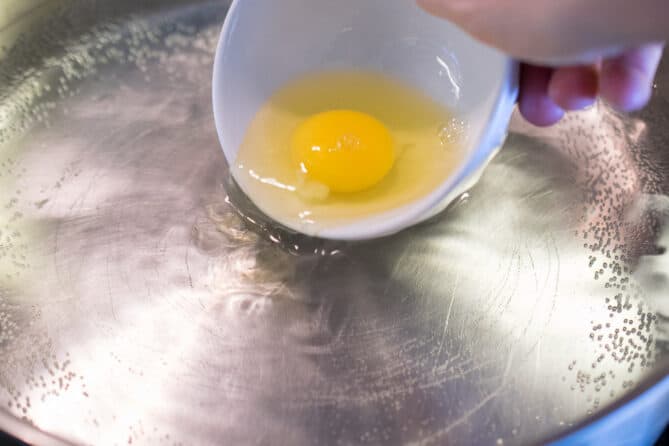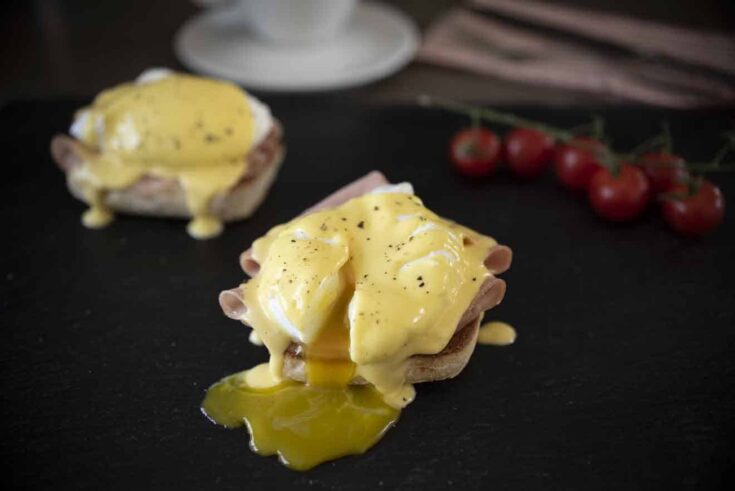Eggs Benedict with Mortadella
The classic Eggs Benedict is everyone’s breakfast and brunch favorite but my own version gets a slight twist by using Mortadella instead of the usual Canadian bacon. My Eggs Benedict with Mortadella is made with a classic hollandaise sauce so you can surprise your family and friends at your next brunch. You and they are going to love it!

This version came about as a happy accident. One weekend morning I was craving eggs Benedict and while gathering my ingredients I discovered I did not have ham and tried it with the fresh mortadella that I had on hand and discovered that it’s oh sooo good! I’m sharing all of my knowledge with you as to how to orchestrate each step for ultimate success.
The key to a successful eggs Benedict is timing. Yep, with this one it’s all about timing. By this, I mean making the hollandaise sauce first, then correctly keeping it at the right temperature while you poach the eggs and, as mentioned above, I’m going to give you all my tips and tricks to get it just right.
Making the best poached eggs is easy, but it’s always good to know the ins and outs because you have to have that amazing runny yolk, right? (see below)

Below, I go more in-depth about in my post for The Easiest Hollandaise Sauce, which I encourage you read before making this sauce because there are some key things you need to know for the sauce to turn out as you want it to.
Eggs Benedict Steps
Have all of your ingredients (mise en place) ready (this includes the hollandaise keeping warm over a water bath) along with a towel or paper towel ready to drain the eggs. Have your English muffins sliced and ready to be toasted, the mortadella slices ready and your cold eggs cracked into small bowls to make it easier to drop into the water.
Your first step is get your poaching water ready. Fill a wide pan that is at least 3 inches/7.5 cms deep, at least three quarters full of water. For every liter/quart of water, add 2 tablespoons clear vinegar. Bring to a boil and add a little salt, stirring to dissolve. Bring down to a light simmer; the perfect temperature is 200°F/400°C. You will need to work in batches of 2 to 3 eggs at a time. Only fit as many eggs in the pan so to not overcrowd the pan.

Gently lower the eggs into the water. Try and get each egg into the pan as quickly as possible so they don’t cook at different rates (you can also make them ahead, check out How to Poach an Egg for the details). Now is the time to toast the English muffins.

Get your plates ready. Check the eggs, use a slotted spoon to lift one out, if the whites are set with no liquid egg white and the yolk is slightly soft to the touch then drain them on the towel.
The muffins should be ready, place them on the plates and top with slices of mortadella and top each them with an egg. Whisk the hollandaise and spoon over the top. That’s it, you just made easy Eggs Benedict!
Alternative to Hollandaise Sauce
If you don’t like hollandaise, I have an Italian Eggs Benedict that I made with a Parmesan sauce that is amazingly good and I recommend you give it a try!
Eggs Benedict with Mortadella

A classic eggs benedict get delicious twist by swapping Canandia bacon for mortadella.
Ingredients
- For the hollandaise:
- 2 large egg yolks
- 2 tablespoons cold water
- 1 ½ cups (330 grams) clarified butter/ghee or unsalted butter, melted and kept warm see note
- Fresh lemon juice to taste
- Salt to taste
- Cayenne pepper, or black pepper (optional)
- 8 large eggs, cold
- 4 English muffins, cut in half
- 16 slices of mortadella
Instructions
- First make the hollandaise:
Collect your equipment needed. A large pot, a stainless steel or glass bowl that fits snuggly inside the pot so steam doesn’t escape and is deep enough so when you add water it does not touch the bottom of the bowl, and a whisk. - Fill the pot with a few inches of water and bring just to a simmer. To the bowl (off the heat) add the egg yolks and cold water. Whisk vigorously until the mix is pale in color and tripled in volume, if you don’t whisk hard enough the sauce can be heavy. This should happen in just under a minute if whisking hard enough. This is now a sabayon.
- Place sabayon bowl over the pan of water whisking vigorously and continuously trying to not splash egg up the sides as it will quickly overcook. If egg on the side of the bowl starts to cook remove bowl and whisk off the heat. The bowl will retain plenty of heat and heat the yolks to a high enough temperature so they properly thicken but not so high that they overcook.
- If undercooked, the sabayon will be runny have an overly eggy flavor and potentially cause the sauce to split If overcooked and yolks begin to look scrambled or curdle like video need to start over. Do not add butter to overcooked eggs as they’ve lost their ability to emulsify the sauce.
- When the sabayon is right, remove it from the heat and whisk for 20 more seconds to prevent overcooking from the bowls residual heat. This stage of the sauce is done when it suspends on the whisk without dripping doubled in volume, thick and creamy. If it is looking scrambled and curdled, you will need to start over.
- Empty the water from the pan that was used to make the first part of the sauce. Cover the pan with a damp cloth. You’re going to be using this to secure the bowl while whisking in the butter. The residual heat from the pan will keep the sauce warm as you add the butter. Place the bowl back on the pan with the cloth.
- Starting whisking and slowly drizzle in the butter using a ladle while whisking. Don’t take too long to add the butter as you can overwork the sauce and will cool down too much and lose it’s air, but don’t add to quickly or it will split. As soon as you see the butter disappear into the sauce it’s safe to add more. Make sure you don’t whisk too much in between additions of butter this will cause the sauce to cool down too much. As butter is added to can see how the sauce begins to thicken.
- When the sauce is relatively thick, this is a good stage to stop adding butter (you will be adding liquid at the end). Don’t make it too thick or you will end up with mayonnaise. Do not incorporate any dried bits that are stuck to the sides of the bowl as this will add lumps to the sauce.
- If you start to see lines of butter on the surface of the sauce, this could cause the sauce to split. You can whisk in a few drops of water and whisk, this will help keep it stable. You should have used about 1 cup of butter at this stage. If the sauce goes quickly from thick to thin, it means you have added too much butter and will look grainy, this means it is broken and you will need to start over. The consistency you are looking for is thick, but still able to pour off a spoon.
- Whisk in enough lemon juice (a little at a time) to your taste. If you add too much lemon, add a little more butter to mellow the flavor. If too thick, you can add a little water to thin out, just be careful to not add to much.
- When done, the sauce should be pale yellow and have a nice sheen. It should be thick, airy and pourable off a spoon.
- Season with salt to taste. You can add pinch of cayenne pepper if you like. If too thick, you can add a little water while whisking. If too thin, it could be to warm and it will thicken a little as it cools.
- Keep warm over a pan of simmering water.
- For the poached eggs:
Fill a wide pan that is at least 3-inches/7.5 cms deep at least three quarters full of water. For every liter of water, add 2 tablespoons clear vinegar. Bring to a boil and add a little salt, stir to dissolve. Bring down to a light simmer, the perfect temperature is 200°F/400°C. You will need to work in batches so to not overcrowd the pan. - Gently lower the eggs into the water, try and get them into the pan as quickly as possible so they don’t cook at different rates (you can also make them ahead, check out How to Poach an Egg for the details). Now is the time to toast the English muffins.
Get your plates ready. Check the eggs, use a slotted spoon to lift one out, if the whites are set with no liquid egg white and the yolk is slightly soft to the touch then drain them on the towel. - The muffins should be ready, place them on the plates and top with slices of mortadella and top each them with an egg. Whisk the hollandaise and spoon over the top. Sprinkle cayenne pepper or black pepper, both optional.
Notes
You may need less butter depending on how quickly the sauce thickens
To keep the butter melted and warm, you can keep it over very low heat, or place in a bowl inside a larger bowl of warm water.
Nutrition Information
Yield
4Serving Size
1Amount Per Serving Calories 528Total Fat 30gSaturated Fat 10gTrans Fat 0gUnsaturated Fat 17gCholesterol 545mgSodium 1193mgCarbohydrates 34gFiber 2gSugar 2gProtein 31g
This nutrition calculation is provided by Nutronix that is only a guideline and not intended for any particular diet.

